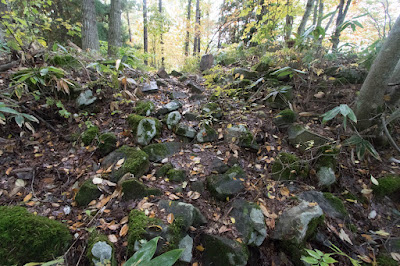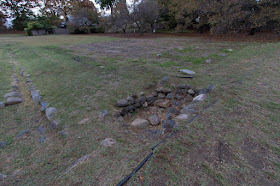Kamogatake Castle
-Fallen but survived-
Overview
Name: Kamogatake castle (Kamogatake-jo)
Alias: Kamagatake-jo
Place: Nakano Nakano city, Nagano
Location: 36.74354585499974, 138.38941814182596
Type: Mountain Castle
Built: Unknown
Remnants: Stone walls, clay walls and dry moats
Title:
20 minutes drive from Joshinetsu Jidoshado Expressway Shinshu-Nakano interchange to parking of Higashiyama-Koen park. 30 minues walk from entrance of climbing road to hilltop castle.
Type: Mountain Castle
Built: Unknown
Remnants: Stone walls, clay walls and dry moats
Title:
Brief History
Kamogatake castle (鴨ヶ嶽城) is located over Kamogatake mountain, one of about 700 meter above from sea level and 300 meter above from hillside at backward of current Nakano city central. Being surrounded by Chikuma-gawa river and Yomasegawa river, Kamogatake mountain is long and narrow ridge spread northward from Misawayama mountain, and due to its sheer slope it has spectacular view of north part of Nagano basin and backward mountains.
Nakano area is half round shaped flat area spread at east of Chikuma-gawa river, being located at middle of Nagano city and Iyama city and separated by bottlenecks from these two areas. Backward of Nakano area is Shiga-Kogen height, and connected to Kusatsu area of Gunma province across Shibu-Toge pass. From castle site whole part of Nakano area and backward mountain road is seen and it was good place to manage the territory.
Origin of Kamogatake castle and Takanashi clan
Kamogatake castle was built as mountain fortress of local lord Takanashi clan, that was branch family of Inoue clan around 1500. Inoue clan originally lived at Inoue area in the south part of current Susaka city, and spread their relative around east part of Chikuma-gawa river such as Suda clan or Takanashi clan. Takanashi clan lived at northernmost area of Inoue territory, and had room of expansion.
Being surrounded in turbulence at collapse of Kamakura Shogunate or conflict between Muromachi Shogunate and South Court, Takanashi clan grew their territory toward north and expelled Nakano clan which formerly held Nakano area. Takanashi clan moved their main base to Nakano area and built traditional style square shaped residence at hillside of Kamogatake mountain. They also built Kamogatake castle at peak of mountain as emergency fortress.
Structure of Kamogatake castle
As it stands at narrow ridge between quite sheer slopes, its structure is simply shaping ridge to terraces and separating them by dry moats. It structure spreads over 600 meter along ridge line, and is separated by five huge V shaped dry moats of over 10 meter width and height processing original height difference of terrain.
Central area of castle is long and narrow oblong shaped one of 40 meter long and 10 meter width, having structure of watching tower at its south edge. Ahead of huge dry moat, northward of central area is layered terraces built toward Hakoyama-Toge pass and Hakoyama castle at further ahead of pass.
At southward of central area, ahead of another huge dry moat there is square shaped secondary area where direct climbing road arrives. Ahead of small terraces and shallow dry moats there is third area that is triangle shape of 20 meter long. This area is protected by huge clay wall and dry moats and it might be the end of original castle.
About 100 meter ahead of this third area, there is Kamagatake castle area which was added at later period. Kamagatake castle is consist of huge 150 meter long and 20 meter wide area, that south end is securely protected by line of stone wall and largest dry moat of 30 meter wide. This defense line clearly assumes combat utilizing matchlock guns.
Peak and crisis of Takanashi clan
Around 1500 Takanashi clan reached to the border of Echigo province (Niigata prefecture) across Chikuma-gawa river and had connection with Nagao clan, the deputy governor of Echigo province and managed Joetsu area ahead of Sekita mountains. In 1507 Tamekage Nagao (1486-1543), leader of Nagao clan and son of daughter of Takanashi clan, raised against governor Fusayoshi Uesugi (1474-1507) and killed him.
In response to this incident main family of Uesugi clan sent large army to Echigo province then Tamekage once escaped to Sado island, but later returned and broke Uesugi army at the battle of Nagamorihara. At this time Takanashi clan sent reinforce army to Tamekage and contributed to his victory, then importance of Takanashi clan in Uesugi clan significantly increased. On the other hand, at this time Murakami clan grew at south half of Nagano basin and both power fell into conflict.
However, Shingen Takeda (1521-1573), the warlord of Kai province (Yamanashi prefecture), intruded into Shinano province and expelled Murakami clan from its main base Katsurao castle (Nagano prefecture) in 1553. Murakami clan asked assistance to Kenshin Uesugi (1530-1578), son of Tamekage Nagao, and Kenshin intervened to Shinano province to support both of Murakami clan and Takanashi clan.
Fall and survival
Shingen Takeda and Kenshin Uesugi fight five times at battle of Kawanakajima for dominance of Nagano basin, and there was no decisive result of battle but Takeda army expanded their territory by plots. Gradually Takahashi clan was suppressed by Takeda army and finally left Nakano area in 1559, retreating to Iiyama castle (Nagano prefecture).
At this time Takanashi clan barely survived by support of Uesugi clan, and gradually became retainer of Uesugi clan. Later Iiyama castle was directly managed Uesugi army, and among internal conflict of Uesugi clan after the death of Kenshin Uesugi, Iiyama area was gave to Takeda clan. Takanashi clan totally lost its position as local lord.
After the fall of Takeda clan in 1582, Uesugi clan once recovered Nagano basin and Takanashi clan was sent to Nakano area again, but as retainer of Uesugi clan. At this time Uesugi clan had to protect this area against Tokugawa clan at south half of Nagano basin or Sanada clan at Kusatsu area with small army then Kamagatake castle area was added at this time to increase security of castle.
Afterward of castle
In 1597, probably for the intention of centralization of Uesugi clan, leader of Takanashi clan was expelled along with other major retainers. Next year Uesugi clan was moved to Aizu area of Mutsu province (Fukushima prefecture) by Toyotomi government, and Kamogatake castle might be abolished at this time. Later Takanashi clan was forgiven and became retainer of Uesugi clan and continued as retainer of Yonezawa domain.
Currently no building remains but terraces, clay walls and dry moats well remain over ridge line. Direct climbing line from hillside temple is quite tough but rewarded by panoramic scenery from hilltop castle. Structure of castle that is long line with up and down is like the history of Takahashi clan, that once experienced peak period but fell in midst of many turbulence but stubbornly survived.
Access
20 minutes drive from Joshinetsu Jidoshado Expressway Shinshu-Nakano interchange to parking of Higashiyama-Koen park. 30 minues walk from entrance of climbing road to hilltop castle.













































